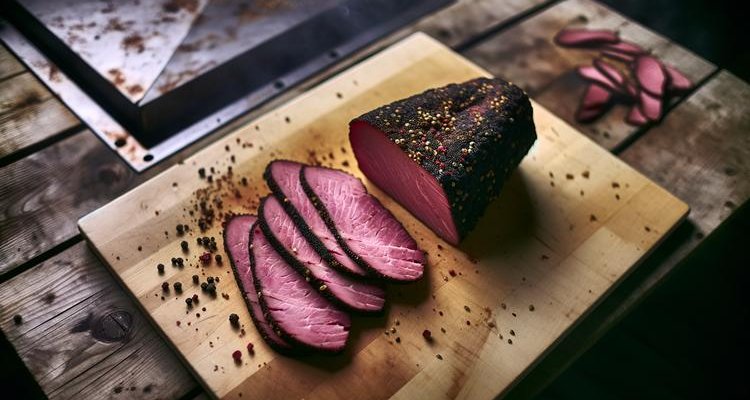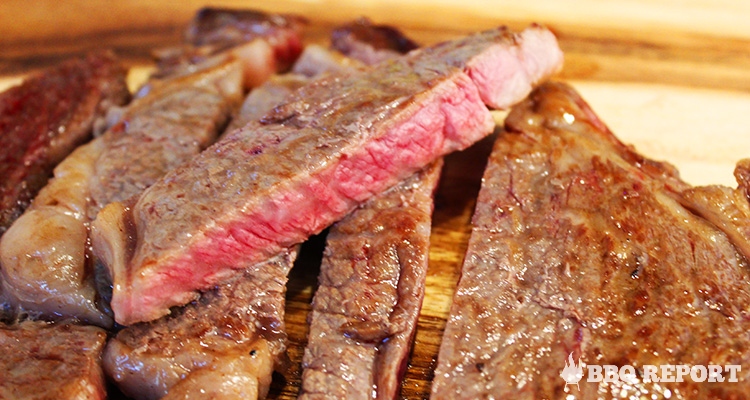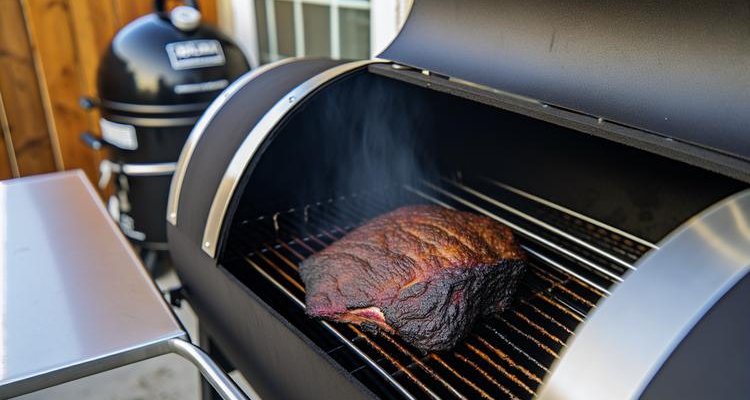
When you’re standing at the competition turn-in box, watching KCBS judges evaluate your brisket, every detail matters. That perfect smoke ring, the tender pull of probe-tested meat, and the glistening bark that catches the light—these aren’t happy accidents. They’re the result of mastering competition-style techniques that separate backyard cooks from grand champions. Whether you’re entering your first BBQ contest or simply want to elevate your brisket game to championship levels, this recipe delivers the precise methods used by winning pit masters across Texas BBQ tradition and beyond.
Understanding Competition Brisket Standards
Competition brisket differs fundamentally from backyard smoking in one critical way: presentation cuts come from the center of the flat. A 12-pound brisket might yield only 6-8 perfect turn-in slices, which is why competitors trim aggressively and focus their efforts on that prime real estate. This same technique benefits home cooks—targeting perfection in the flat’s center rather than trying to cook every inch identically.
KCBS judges evaluate brisket on appearance, tenderness, and taste. That perfect smoke ring, probe-tender texture, and glistening bark aren’t optional—they’re the foundation of winning scores. Every technique in this recipe serves these three judging criteria.
Selecting Your Competition Brisket
Competition brisket starts at the butcher counter. Look for Prime grade beef whole packer weighing 12-16 pounds—this size range ensures even cooking while providing enough meat for presentation. The flat should measure at least 2 inches thick at its deepest point, with abundant marbling throughout.
Inspect the fat cap for flexibility; it should bend without cracking, indicating freshness. Snake River Farms Wagyu and certified Angus beef are popular choices in competition circles, though any Prime brisket with thick flat and good marbling will deliver championship results.
Expert Trimming for Competition Standards
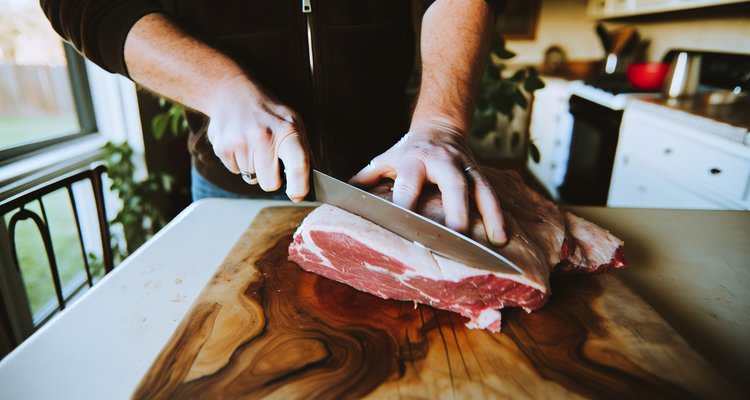
Trimming separates novices from serious competitors. Using a sharp brisket knife, remove the hard white fat between the point and flat—this dense fat won’t render during cooking and creates unappetizing texture. For comprehensive guidance on all essential brisket trimming tools, consult our equipment reviews.
Trim the fat cap to 1/4 inch thickness across the entire brisket, though some pellet grill competitors prefer 1/8 inch for better smoke penetration and bark formation. Here’s a competition-specific technique rarely seen in backyard recipes: score the fat cap in a diagonal criss-cross pattern with shallow cuts spaced 1 inch apart. This allows rub to penetrate deeper while helping fat render more evenly.
For offset smoker cooking, trim the flat to approximately 1/2 to 3/4 inch larger than your turn-in box dimensions, focusing trimming efforts on the center section where presentation slices originate.
Competition Injection and Rub Technique
While Texas purists like Aaron Franklin skip injection, competition BBQ embraces it for moisture insurance during long cooks. Mix 1 cup beef broth with 2 tablespoons beef bouillon, 1 teaspoon white pepper, 1 teaspoon garlic powder, and 1 teaspoon onion powder. Using a meat injector, inject in a 1-inch grid pattern across both the flat and point, inserting at angles to distribute liquid evenly without pooling.
For the rub, competition brisket keeps it simple but strategic. The classic 50/50 blend of coarse kosher salt and 16-mesh black pepper remains the gold standard, though many competitors add a proprietary BBQ rub for complexity. Apply injection liquid or yellow mustard as a binder, then pat—don’t rub—the seasoning onto all surfaces. The patting motion preserves bark potential better than aggressive rubbing.
The Cold Start Advantage
Here’s a competition secret that dramatically improves smoke penetration: the cold start method. After seasoning, refrigerate your brisket for 1-3 hours until internal temperature drops to 40-45°F. Preheat your smoker to just 180°F and place the cold meat directly on the grates.
Smoke at this low temperature for exactly 1 hour—cold meat absorbs smoke compounds more readily, building that coveted smoke ring. After the first hour, increase temperature to 225°F for the remainder of the cook.
Smoking Process for Perfect Bark
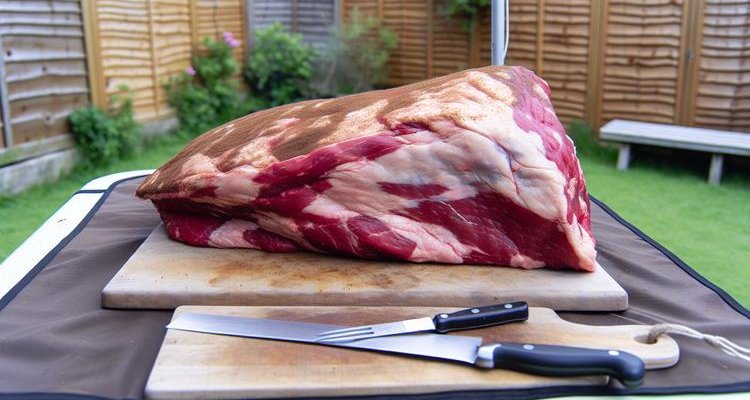
Whether using an offset smoker with post oak (the Texas standard) or a pellet grill with oak pellets, master smoking techniques and maintain steady temperature control at 225-250°F throughout the cook. Place a water pan in the cook chamber to stabilize temperature and add humidity, which improves bark formation.
For offset smokers, position the brisket fat-side up with the point toward the firebox where heat is most intense. Starting at the 2.5-hour mark, spritz the brisket with a 50/50 mix of apple juice and water every hour. This keeps the surface moist enough for continuous smoke adhesion without washing away the developing rub.
Monitor using a wireless thermometer, but resist the urge to open the smoker unnecessarily—every peek costs you heat and extends cooking time. Expect approximately 1 to 1.25 hours per pound at 225°F, meaning a 14-pound brisket requires 14-17 hours total. Pellet grills tend toward the faster end of this range due to more consistent heat distribution, while offset smokers may require the full time estimate.
The Wrapping Decision: Texas Crutch vs Butcher Paper
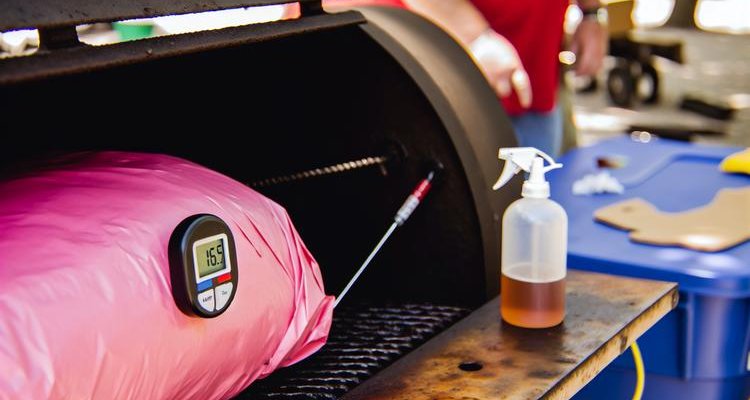
When internal temperature reaches 160-170°F, you’ll face the critical wrapping decision. Competition BBQ uses two primary methods, each with distinct advantages:
Pink Butcher Paper Method (Aaron Franklin’s preference): Wrap when the bark reaches your desired color and darkness, typically around 165°F. Pink butcher paper allows the brisket to continue breathing slightly, maintaining bark integrity while still accelerating the cook through the stall. This method produces the best bark texture for competition presentation.
Aluminum Foil Method (Traeger/Tipsy Brisket approach): Wrap at exactly 160°F internal temperature with a double layer of heavy-duty foil, adding 1/2 cup beef broth before sealing. The foil creates a complete vapor barrier, pushing through the stall fastest and producing incredibly tender, moist meat. However, bark may soften slightly—acceptable for many competitions but not ideal if bark texture is judged heavily.
For first-time competitors, butcher paper offers the best balance: impressive bark with reliable tenderness. Keep the brisket wrapped for the remainder of the cook after whichever method you choose.
Probe Tenderness and Target Temperature
Forget relying solely on temperature numbers. Competition brisket is done when it’s probe tender—meaning a thermometer probe or skewer slides through the flat with the resistance of soft butter (some describe it as peanut butter consistency). This typically occurs between 200-205°F internal temperature, but the exact number varies by brisket.
Begin probe testing at 195°F. Insert a probe into the thickest part of the flat; if you feel significant resistance, continue cooking and test every 15 minutes. When the probe slides in effortlessly with just slight resistance, your brisket has reached competition-ready tenderness regardless of the exact temperature displayed.
Resting and Competition Presentation
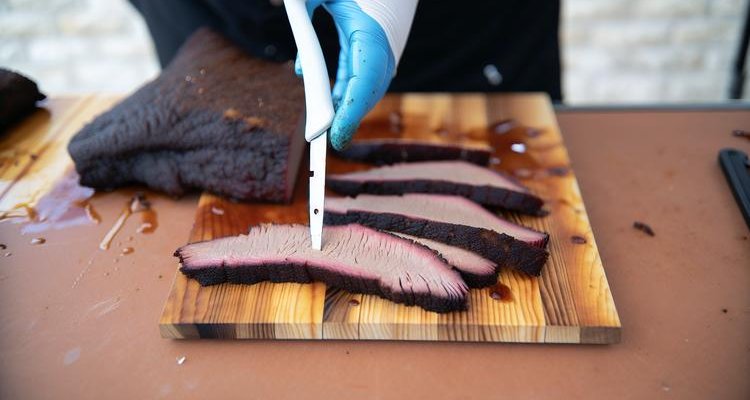
Remove the wrapped brisket from the smoker and let it rest in a dry cooler or insulated cambro for a minimum of 1 hour, though 2-4 hours produces even better results as juices redistribute throughout the meat. Longer rest times allow carryover cooking to finish tenderizing connective tissue while keeping the brisket at food-safe temperatures above 140°F.
For competition slicing, separate the point from the flat by following the fat seam between them. Slice the flat into pencil-thick pieces (approximately 1/4 inch) against the grain. Rotate the point 90 degrees and slice slightly thicker (3/8 inch) to maintain structure. For competition turn-in, select the 6-8 most uniform, centered slices from the flat.
Competition finishing touches: use a silicone brush to paint slices with strained au jus from the wrapping, then dust very lightly with a powdered blend of your rub mixed with a pinch of MSG. Keep slices touching each other until service to prevent oxidation and maintain that fresh-cut appearance KCBS judges reward.
Pellet Grill Adaptations for Competition BBQ
Pellet grills have become increasingly popular in BBQ competition culture, offering temperature consistency that rivals expensive offset smokers. For competition brisket on a pellet grill, use these specific settings: cold start at 180°F for 1 hour, then increase to 225°F for the duration.
Oak pellets most closely replicate traditional Central Texas post oak flavor, though competition blends combining oak with cherry or hickory are gaining popularity. The key difference with pellet grills: wrap slightly earlier (155-160°F) since pellet smokers produce bark faster with their consistent radiant heat.
Monitor with dual-probe thermometers to track both ambient chamber temperature and internal meat temperature simultaneously—pellet grill temperature displays can vary 10-15°F from actual grate-level conditions. Home cooks seeking convenience may also consider electric smokers as an alternative, though pellet grills remain the competition standard for consistent results.
Ready to master more championship-level dishes? Explore our full collection of smoked recipes to expand your competitive BBQ repertoire.
Frequently Asked Questions
What grade of brisket is best for competition BBQ?
Prime grade beef is the standard for competition brisket, offering the marbling necessary for tenderness and flavor during 12+ hour cooks. While Choice grade can produce acceptable results, the higher fat content in Prime helps the brisket stay moist through the stall and produces better bark. Look for USDA Prime with a thick flat (2+ inches) and flexible fat cap—Snake River Farms Wagyu and certified Angus Prime are popular competition choices.
Should I wrap brisket in foil or butcher paper for competition?
Pink butcher paper is preferred by most competition pit masters for superior bark texture, though aluminum foil produces more tender results. Butcher paper allows the brisket to breathe slightly while still pushing through the stall, maintaining that crispy bark judges love. Wrap with butcher paper when bark color looks right (around 165°F internal). Foil creates a vapor seal that softens bark but guarantees fall-apart tenderness—acceptable for many competitions where tenderness outweighs bark texture. For your first competition, use butcher paper at 165°F to balance both judging criteria.
How do I know when my competition brisket is done?
Competition brisket is done when it’s probe tender, not when it hits a specific temperature. Insert a thermometer probe or metal skewer into the thickest part of the flat—it should slide through with the resistance of room-temperature butter, typically occurring between 200-205°F internal temperature. Start testing at 195°F and check every 15 minutes thereafter. If you feel resistance, continue cooking regardless of temperature. The “probe test” is the gold standard in competition BBQ because every brisket tenderizes at slightly different temperatures depending on collagen content and marbling distribution.
How long does it take to smoke a brisket per pound?
Plan for 1 to 1.25 hours per pound at 225°F for competition brisket, meaning a 14-pound whole packer requires 14-17 hours total cook time. Pellet grills trend toward the faster end (1 hour per pound) due to consistent heat, while offset smokers often require the full 1.25 hours per pound. However, cooking time varies significantly based on brisket thickness, wrapping method, and whether you use the cold start technique. Always cook to probe tenderness rather than strict time estimates—rushing a brisket to meet a deadline results in tough, chewy meat that judges penalize heavily. Start your cook 18-20 hours before turn-in time to allow buffer for rest periods and unexpected stalls.
Do I rest brisket wrapped or unwrapped for competition?
Rest your competition brisket still wrapped in its butcher paper or foil inside a dry cooler or insulated cambro for 1-4 hours before slicing. Keeping the wrap intact during the rest period retains moisture and allows the internal temperature to equalize throughout the meat—juices redistribute from the center back to the drier outer areas. A minimum 1-hour rest is mandatory, but 2-4 hours produces noticeably better results for competition presentation. The extended rest time also provides flexibility in competition schedules; a properly rested brisket in a cambro stays above 140°F (food safe) for up to 6 hours, letting you time your turn-in perfectly without rushing.
Competition-Style Brisket Recipe
Equipment
- Offset smoker or pellet grill
- Wireless meat thermometer
- Meat injector
- Sharp brisket knife
- Pink butcher paper or heavy-duty aluminum foil
- Spray bottle
- Insulated cooler or cambro
- Cutting board
Ingredients
- 1 whole packer brisket 12-16 lbs, Prime grade
- 1 cup beef broth for injection
- 2 tablespoons beef bouillon powder
- 1 teaspoon white pepper
- 1 teaspoon garlic powder for injection
- 1 teaspoon onion powder
- 1 cup coarse kosher salt
- 1 cup 16-mesh black pepper
- 1/4 cup yellow mustard binder
- 2 cups apple juice for spritz
- 2 cups water for spritz
- 1/2 cup beef broth for foil wrapping, if using
- post oak wood chunks or oak pellets
Instructions
- Select a Prime grade whole packer brisket weighing 12-16 pounds with thick flat (2+ inches) and good marbling throughout.
- Trim hard white fat between point and flat. Trim fat cap to 1/4 inch thickness. Score fat cap in diagonal criss-cross pattern with 1-inch spacing.
- Prepare injection: Mix 1 cup beef broth, 2 tablespoons beef bouillon, 1 teaspoon white pepper, 1 teaspoon garlic powder, and 1 teaspoon onion powder.
- Inject brisket in 1-inch grid pattern across flat and point, inserting at angles to distribute evenly.
- Apply yellow mustard as binder. Mix 1 cup kosher salt with 1 cup 16-mesh black pepper. Pat (don't rub) seasoning onto all surfaces.
- Refrigerate seasoned brisket for 1-3 hours until internal temperature drops to 40-45°F.
- Preheat smoker to 180°F. Place cold brisket on grates fat-side up (offset) or per manufacturer recommendations (pellet).
- Smoke at 180°F for exactly 1 hour for maximum smoke penetration.
- Increase temperature to 225°F. Add water pan to cook chamber. Maintain 225-250°F throughout cook.
- Starting at 2.5 hours, spritz with 50/50 apple juice and water mixture every hour.
- When internal temperature reaches 165°F and bark is dark, wrap in pink butcher paper. Alternatively, wrap in double-layer foil at 160°F with 1/2 cup beef broth.
- Continue cooking wrapped until internal temperature reaches 195°F, then begin probe testing.
- Test probe tenderness by inserting thermometer probe into thickest part of flat. When probe slides through with butter-like resistance, brisket is done (typically 200-205°F).
- Remove from smoker and rest wrapped in dry cooler or cambro for minimum 1 hour, preferably 2-4 hours.
- Separate point from flat by following fat seam. Slice flat into pencil-thick slices (1/4 inch) against the grain.
- Rotate point 90 degrees and slice slightly thicker (3/8 inch) to maintain structure.
- For competition: Paint slices with strained au jus, dust with powdered rub blend. Keep slices touching until service.
Notes
Contents
- Understanding Competition Brisket Standards
- Selecting Your Competition Brisket
- Expert Trimming for Competition Standards
- Competition Injection and Rub Technique
- The Cold Start Advantage
- Smoking Process for Perfect Bark
- The Wrapping Decision: Texas Crutch vs Butcher Paper
- Probe Tenderness and Target Temperature
- Resting and Competition Presentation
- Pellet Grill Adaptations for Competition BBQ
- Frequently Asked Questions
- Competition-Style Brisket Recipe

